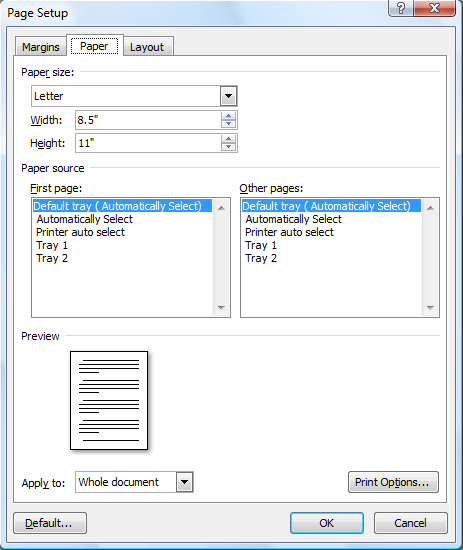Please Note: This article is written for users of the following Microsoft Word versions: 2007, 2010, 2013, 2016, 2019, and 2021. If you are using an earlier version (Word 2003 or earlier), this tip may not work for you. For a version of this tip written specifically for earlier versions of Word, click here: Selecting a Paper Source.
Written by Allen Wyatt (last updated January 24, 2024)
This tip applies to Word 2007, 2010, 2013, 2016, 2019, and 2021
Word supports any printer supported by Windows. This is because Word uses the features offered by Windows to print documents. Many of the features associated with formatting your document and printing are related to the type of printer you have installed and selected. For instance, some laser printers have different bins for different paper. Windows (and thus Word) can instruct the printer to select paper from any of the available paper bins.
If your printer supports multiple paper sources and you want to change the paper source used for your document (for instance, you have a bin that contains letterhead and you want to print on it), you should follow these steps if you are using Word 2007:

Figure 1. The Paper tab of the Page Setup dialog box.
If you are using Word 2010 or a later version, the steps to check which printer is selected are slightly different. Instead of steps 1 through 3, press Ctrl+P to display the Print options on the File tab. Use the Printer drop-down list to specify which printer you want to use. You can then press Esc (to get back to your document) and follow steps 4 through 9 as indicated.
If, in step 7, you don't see different options for paper sources, then your printer (or printer driver) does not support multiple sources. Once you have specified different sources for your paper, the information is saved with the document. This means that every time you print the document, it will select paper as you directed. This also applies to using the print-merging feature of Word. For instance, the first page of each document merged and printed can be selected from a different bin than each subsequent page.
WordTips is your source for cost-effective Microsoft Word training. (Microsoft Word is the most popular word processing software in the world.) This tip (8798) applies to Microsoft Word 2007, 2010, 2013, 2016, 2019, and 2021. You can find a version of this tip for the older menu interface of Word here: Selecting a Paper Source.

Create Custom Apps with VBA! Discover how to extend the capabilities of Office 365 applications with VBA programming. Written in clear terms and understandable language, the book includes systematic tutorials and contains both intermediate and advanced content for experienced VB developers. Designed to be comprehensive, the book addresses not just one Office application, but the entire Office suite. Check out Mastering VBA for Microsoft Office 365 today!
Need to add a unique serial number to each printed copy of your document? Here's a quick way to print such numbered versions.
Discover MoreWant your document to print out the same on printers other than your own? This may be an elusive quest, as explained in ...
Discover MoreWhen you create documents that rely on markup (tracked changes and comments), getting usable printed output that includes ...
Discover MoreFREE SERVICE: Get tips like this every week in WordTips, a free productivity newsletter. Enter your address and click "Subscribe."
There are currently no comments for this tip. (Be the first to leave your comment—just use the simple form above!)
Got a version of Word that uses the ribbon interface (Word 2007 or later)? This site is for you! If you use an earlier version of Word, visit our WordTips site focusing on the menu interface.
Visit the WordTips channel on YouTube
FREE SERVICE: Get tips like this every week in WordTips, a free productivity newsletter. Enter your address and click "Subscribe."
Copyright © 2026 Sharon Parq Associates, Inc.
Comments